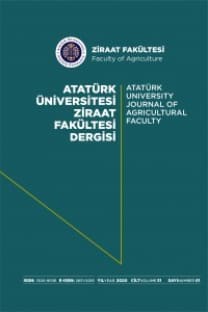ERZİNCAN OVASI TOPRAK VE SU KAYNAKLARININ SULAMA YÖNüNDEN PROBLEMLERİ VE GELİŞTİRİLME İMKANLARI ÜZERİNDE BİR ARAŞTIRMA
ÖZETBu çalışmada, Erzincan Ovası topraklarının sulama yönünden önemlikarekterleri incelenmiş ve bölgede tatbik edilen sulama metodlarıtespit edilmiştir. Bilhassa drenaj problemlerinin mevcut olduğu kısımlardaıslatılması gereken toprak derinliği tespit edilmeye çalışılmıştır.Sulamada kullanılan su kaynaklarının sulamaya elverişlilik yönündenJln!flandınlmaları yapılmış ve sulama tatbikatlarında emniyetle kullanılıpkullanılmayacağı tayin edilmiştir. Ovada uygulanan bitki paternigözönünde bulundurularak, her bitkinin aylık ve mevsimlik su tüketimihesaplanmış, daha sonra randımanlar da dikkate alınarak ovanın toplamsulama suyu ihtiyacı hesaplanmıştır.A RESEARCH ON THE PROBLEMS AND lMPROVEMENT POSSIBILITIES OF SOIL-WATERRESOURCES OF ERZİNCAN VALLEY FOR IRRIGATION.The goal of this research is tostudy soil-water relations and to helpuse of present soil and water resourcesmore productively. For this purposesoil charecteristics of these soils whichare important for irrigation purposesand quality of irrigation water and waterrequirement of vaUey are investigatedand advices are given to takenecassary measurements.The result of the research carriedout on irrigation and soils of ErzincanvaUey can be summarized as below:1- The irrigation project of Erzincanvalley is planned of irrigate8250 hectares of irrigable lan.d of27437 hectares, At present day, the completedproject encloses only 7 000 hectaresof land; but today only % 70of this area is irrigated.The main course of the low-irrigationachievement is largely the resultof farmer's lack of experience in irrigationpractice and the lack of organizatİon.As a result of farmer's lack ofexperience in irrigation; the irrigationfield efficieny of the existing' irrigation;the irrigation field effiviencyo f the existing irrigation system as low% 32 to % 58.2- The investigated soils of Erzincanvalley are mainly loamy soils. Thesoil profites show differential layers.in general, the investigated soils aresatisfactory for plant growth and inwater holding capacity,3- The particıe density of soilsvary from, 2,22 to 2,95 and bulk densityfrom 0,73 gr/cm 3 to 1,79 gr/cm3. Thegreat variation in bulk density is dueto soils layers.4· The porosity of ınvestigatedsoils is varying along the layers of soilprofHes and have the value of % 27,16to % 70,17.5- The total porosity of soils consistof % 0,5 - %43,20 large (non capillar),% 7,71 - % 81,10 middle and% 5,20 - % 72,23 tight or confined capillar.The distribution of porosityshows that, the investigated soils havea low air capaçity. In the view of thisfact, these soils should be irrigatedwith care, so that the aif capacity ofthe soils maintained at at favourablelevel to the plant roots6- The hydraulil! conductivity ofthe searched soils is varying with respectto the non cappillar porosity,from 0.02 cm/holl! to 23,20 cm/hour.7- The constant intake rate of thesoils range from 0,5 cm/hour to 50,2cm/hour.With respect to the intake rate,the investigated soils mostly fall into"high" infiltration class.The accumulated infiltratioI1 (y)is expressed in the from of, y = a.tııThe constant (a) and (n) in this equationvaries in a wide range.8- The retention of water by soilsvaries with layers of soil profites in agreat variation.With respect to the moisture retention,there exist a correlation betweendayand silt content of soils.in general, the water holding capacityof the investigated soils are bigh.But soils that have a high percentageof day, also have a available moisturehigh wilting percentage and thus a lowrange.9- For the first 60 cm depth of SO~il profiles; the moisture range betweenfield capaeity and permanentwilting percentage vary from 3,3 cmto 15,2 cm.10- For the [irst 60 cm depth ofsoi1s of searched area, time requiredto bring the moisture content of soilsfrom wi1ting percentage to the fieldcapacity vary from 0,25 hours 10,75hours.11- For a uDifoem water distrubitionin the soils, irrigation water shouldreach to the end of the furrows in1{4 of the time required to WL the rootzone of he plants.Wjth respect to the above fact;the calculated time, in which the irrigationwater to reaeh the end of furrowsvaries from 0,06 hours to 2,68hours.12- In the searched area, wheredrainage proleıns exist, the groundwater table is about 20 em belaw thesurface.13- The water used for irrigationin the investigated area, is classifiedas CıS ı and C2SI'14- The irrigable land of the İnvestigatedarea is abont 27 437 hectareswith a rotatian fitting the existing conditionin the area, the fol1owing plantpattem can be espected :Small grain % 45,2; sugarbeet% 25,4; vegetable % 12,7; forage plant% 8,8'; orehards % 3,4; potatoes% 2'6 and dry beans % 2.0 of the irrigableland.The irrigation water requirement,caleulated by the Blaney-Criddle Method;is for smaIl grain 371,5; for sugarbeet686,2; for vegetables 415,7;for forage plant 642,5 m.'11 and for orchards562,9 mm.Taking the proposed plant rotationinto consideration, the estimatedseasonal irrigation requirement of theinvestigated area is about 1091,5 mm(based on in irrigation field effeeiencyof % 45) The caıCulated peak demandof the irrigation requirement of thearea is 350,2 mm in Jluly.if the irrigation water is conveyedby lined ehannels the above amountwill rise to 4LO and if water conveyedby earth channels it would beabout 500,3 mm.
Anahtar Kelimeler:
-
- ISSN: 1300-9036
- Yayın Aralığı: Yılda 3 Sayı
- Yayıncı: AVES Yayıncılık
